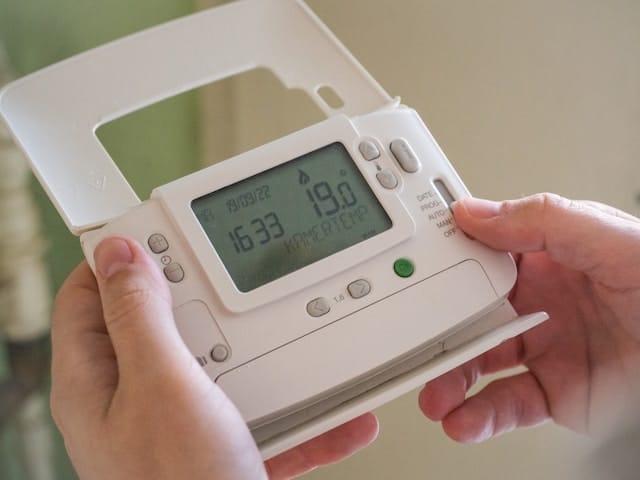To install a smart thermostat is one of the most effective ways to enhance your home’s energy efficiency while optimizing your heating and cooling systems. A smart thermostat allows you to control your home’s temperature remotely, learn your preferences, and adapt to your schedule. This technology not only provides convenience but also contributes to significant energy savings over time, which can lead to lower utility bills.
As energy costs continue to rise, investing in a smart thermostat can pay for itself within a year through the savings it generates. Furthermore, many smart thermostats provide features such as energy usage reports, reminders for filter changes, and integration with other smart home devices, making it a smart choice for homeowners looking to modernize their home.
In this guide, we will explore the steps involved to install a smart thermostat and how to make the most of its features for optimal energy savings. Whether you’re a DIY enthusiast or a homeowner looking to upgrade your home’s energy efficiency, this guide will provide the necessary information to help you successfully install and use a smart thermostat.
Understanding Smart Thermostats
Before diving into the process of how to install a smart thermostats, it’s essential to understand what a smart thermostat is and how it works.
What is a Smart Thermostat?
A smart thermostat is a device that manages your home’s heating and cooling system by connecting to Wi-Fi, allowing you to control it remotely through a smartphone app or web interface. Smart thermostats learn your preferences over time, automatically adjusting the temperature based on your habits. Some popular models include:
- Nest Learning Thermostat: Learns your schedule and programs itself.
- Ecobee SmartThermostat: Features room sensors to ensure balanced heating and cooling.
- Honeywell Home T9: Offers geofencing and compatibility with various smart home platforms.
Benefits of Smart Thermostats
- Energy Savings: Smart thermostats can reduce your energy bills by optimizing your heating and cooling based on usage patterns.
- Remote Control: Adjust your home’s temperature from anywhere using your smartphone.
- Energy Reports: Monitor your energy usage and receive insights to help you save more.
- Integration: Connect with other smart home devices for enhanced automation.
Preparing for Installation
Before you install a smart thermostat, you need to prepare adequately. Here’s what you should do:
1. Check Compatibility
Ensure your heating and cooling system is compatible with the smart thermostat you intend to install. Most smart thermostats work with conventional HVAC systems, but it’s essential to verify this. Visit the manufacturer’s website for compatibility details.
2. Gather Necessary Tools
You’ll need a few basic tools to install your smart thermostat:
- Screwdriver (flathead and Phillips)
- Drill (optional)
- Level
- Smartphone or tablet (for app installation)
3. Turn Off Power
Before beginning any installation, turn off the power to your heating and cooling system at the circuit breaker to avoid electric shock.
Installation Steps
Now that you’re prepared, follow these steps to install your smart thermostat:
Step 1: Remove the Old Thermostat
Take a Picture: Before removing the old thermostat, take a picture of the existing wiring to reference during the installation.
Disconnect the Wires: Carefully unscrew the wires from the old thermostat. Label each wire with masking tape to avoid confusion during the installation of the new thermostat.
Remove the Wall Plate: Unscrew and remove the wall plate from the wall. If necessary, patch any holes left behind.
Step 2: Install the Smart Thermostat Base
Attach the Base: Align the new thermostat’s base with the existing wiring. Use the level to ensure it’s straight. Secure it to the wall with screws.
Connect the Wires: Following the labels from your old thermostat, connect the wires to the corresponding terminals on the smart thermostat base. Most thermostats will have labeled terminals (e.g., R, W, Y, G). Refer to the manufacturer’s wiring diagram if you’re unsure.
Attach the Display: Once the wires are connected, snap or screw the display onto the base.
Step 3: Power On and Set Up
Restore Power: Go back to the circuit breaker and restore power to your HVAC system.
Download the App: Download the smart thermostat’s companion app on your smartphone or tablet. Create an account and follow the prompts to connect your thermostat to Wi-Fi.
Follow Setup Instructions: The app will guide you through the setup process, including configuring your heating and cooling preferences.
Optimizing Your Smart Thermostat for Energy Savings
Once your smart thermostat is installed, here are some tips to maximize energy savings:
1. Set a Schedule
Program your thermostat to follow a schedule that matches your lifestyle. For example, set the temperature lower when you’re away during the day and higher when you return home.
2. Use Geofencing
Many smart thermostats offer geofencing capabilities, which adjust the temperature based on your location. This feature ensures that your home is at a comfortable temperature when you arrive while saving energy when you’re away.
3. Monitor Energy Usage
Take advantage of the energy reports provided by your smart thermostat. Analyze your usage patterns to identify areas where you can save energy.
4. Integrate with Other Smart Devices
If you have other smart home devices, consider integrating them with your thermostat. For example, connect it to smart blinds or lights to optimize energy use throughout your home.
5. Regular Maintenance
Ensure your heating and cooling system is well-maintained. Change air filters regularly and schedule professional maintenance to keep your system running efficiently.
Troubleshooting Common Issues
If you encounter issues with your smart thermostat, here are some troubleshooting tips:
1. Connectivity Issues
If your thermostat isn’t connecting to Wi-Fi, ensure you have a strong signal. Restart your router and thermostat, and try reconnecting through the app.
2. Incorrect Temperature Readings
If the thermostat shows inaccurate temperature readings, check the placement of the thermostat. It should be away from direct sunlight, drafts, or heat sources.
3. HVAC System Not Responding
If your HVAC system doesn’t respond to the thermostat, ensure all wires are securely connected. If the problem persists, consult the manufacturer’s troubleshooting guide.
Additional Considerations for Energy Savings
To further enhance energy savings and the efficiency of your smart thermostat, consider the following strategies:
1. Utilize Energy-Saving Modes
Many smart thermostats come with energy-saving modes that reduce energy consumption while maintaining comfort. Look for features like Eco mode or Energy Savings mode and activate them when appropriate.
2. Adjust for Seasonal Changes
Make adjustments to your thermostat settings based on seasonal changes. In the summer, set your thermostat to a higher temperature when you’re away, and in the winter, set it to a lower temperature. This simple change can result in substantial energy savings.
3. Educate Family Members
Ensure all family members are aware of the new smart thermostat features and settings. Encourage them to use the app or voice control to adjust temperatures as needed. Having everyone on board can maximize efficiency.
4. Invest in Smart Sensors
Consider investing in smart sensors that monitor temperature and occupancy in different rooms. These sensors can provide data to your thermostat, allowing it to adjust temperatures based on where people are in the house. This targeted approach can lead to more efficient heating and cooling.
5. Take Advantage of Rebates and Incentives
Many utility companies and government programs offer rebates or incentives for installing energy-efficient devices like smart thermostats. Check with your local utility provider to see what programs are available in your area.
Long-Term Benefits of Smart Thermostats
Investing in a smart thermostat can offer long-term benefits beyond just energy savings. Here are a few advantages to consider:
1. Increased Home Value
Homes equipped with smart technology, including smart thermostats, can appeal more to potential buyers. Many buyers are looking for energy-efficient features, making your home more attractive in a competitive market.
2. Enhanced Comfort
Smart thermostats provide personalized comfort settings, adapting to your preferences. They can maintain an optimal temperature at all times, ensuring that you always come home to a comfortable environment.
3. Environmental Impact
By optimizing energy usage, smart thermostats contribute to reducing overall energy consumption, which in turn lowers greenhouse gas emissions. This is a significant benefit for environmentally conscious homeowners.
Conclusion
Installing a smart thermostat is a straightforward process that can lead to significant energy savings and increased comfort in your home. By following the steps outlined in this guide, you can successfully install and optimize your thermostat for maximum efficiency.
In today’s world, where energy conservation is essential for both financial and environmental reasons, a smart thermostat offers a simple yet effective solution. With its ability to learn your habits, provide insights into energy usage, and integrate with other smart devices, you can create a more efficient home environment.
By taking the time to install and configure your smart thermostat correctly, you can enjoy a comfortable living space while saving money on energy bills. Embrace this technology and take the first step towards a smarter, more energy-efficient home!
For more information on smart thermostats and energy efficiency, check out the following links:
- Explore smart thermostat options and reviews at Consumer Reports.
- Learn about energy-saving tips and strategies at Energy.gov.






